Did you know that Monaco, one of the smallest countries in the world, is leading the way in integrating biodiversity into its built environment? Let’s explore Monaco Biodiversity and the Built Environment in more detail. With its commitment to sustainable architecture design, urban landscaping, and ecological conservation, Monaco is setting new standards for green infrastructure development and environmental planning strategies. The principality’s efforts in wildlife habitat preservation and ecological urban development are truly remarkable, showcasing its dedication to creating a harmonious coexistence between nature and development.
Monaco Biodiversity and the Built Environment Key Takeaways:
- Monaco is actively integrating biodiversity into its built environment through sustainable architecture design and urban landscaping.
- The principality’s commitment to ecological conservation is evident in its green infrastructure development and environmental planning strategies.
- Wildlife habitat preservation is a top priority in Monaco, ensuring the protection of diverse species and their natural habitats.
- Ecological urban development practices in Monaco aim to create sustainable and environmentally-friendly neighborhoods.
- Biodiversity integration in construction projects is a key focus in Monaco, promoting the preservation of nature in urban areas.
Forest Cover in Monaco
Monaco, with its small size and urban development, does not have significant forest cover. This lack of forested areas directly impacts Monaco’s biodiversity as forests provide vital habitats for a diverse range of species.
Between 1990 and 2000, no changes in forest cover were reported in Monaco. The absence of forested areas restricts the number of plant and animal species that can thrive in the country, further impacting its biodiversity.

It is worth noting that the preservation and expansion of forest cover is crucial for maintaining and enhancing biodiversity. Forests serve as important ecosystems that support a wide variety of plant and animal life. They provide food, shelter, and breeding grounds for numerous species, contributing to the overall health and balance of the environment.
The impact of forest cover on biodiversity cannot be understated. By creating suitable habitats for various species, forests play a vital role in supporting the interconnected web of life on Earth. Protecting and restoring forested areas is essential for preserving the planet’s rich biodiversity.
While Monaco may not have substantial forest cover, there are other measures in place to protect and preserve the country’s biodiversity. Initiatives such as marine protected areas and wildlife conservation efforts contribute to the overall conservation goals of Monaco.
Diverse Species and Biodiversity
Despite the limited forest cover in Monaco, the country is still home to a diverse array of plant and animal species. The unique ecological conditions in Monaco, including its coastal environment and protected marine areas, provide habitats for a variety of species. There is a total of 74 animal species in Monaco.
However, efforts to restore and expand forest cover in Monaco would have significant benefits for both local biodiversity and the overall health of the ecosystem. By creating more forested areas, Monaco can provide additional habitats, enhance species diversity, and contribute to global conservation efforts.
Protected Areas in Monaco
Monaco boasts limited but significant protected areas that play a vital role in conservation efforts. Among these are two marine protected areas covering a total of 35.5 hectares. These areas are essential for safeguarding the diverse marine biodiversity found in Monaco’s territorial waters.
Moreover, Monaco’s commitment to environmental preservation extends beyond its own boundaries. The principality is an active participant in the PELAGOS Sanctuary for Mediterranean Marine Mammals, which covers a vast area of the Ligurian Sea. Designated as a Specially Protected Area of Mediterranean Importance (SPAMI) by the Barcelona Convention, the PELAGOS Sanctuary aims to protect and conserve the region’s marine mammals, ensuring their natural habitats remain undisturbed.
“The protection of marine ecosystems is of paramount importance to Monaco. We recognize the immense value of our oceanic resources and work tirelessly to ensure their preservation for future generations.”
Monaco’s participation in these marine protected areas and the PELAGOS Sanctuary demonstrate its proactive approach to biodiversity conservation and environmental stewardship. By safeguarding its marine habitats, Monaco contributes to the greater global efforts towards sustainable development and the preservation of natural resources.
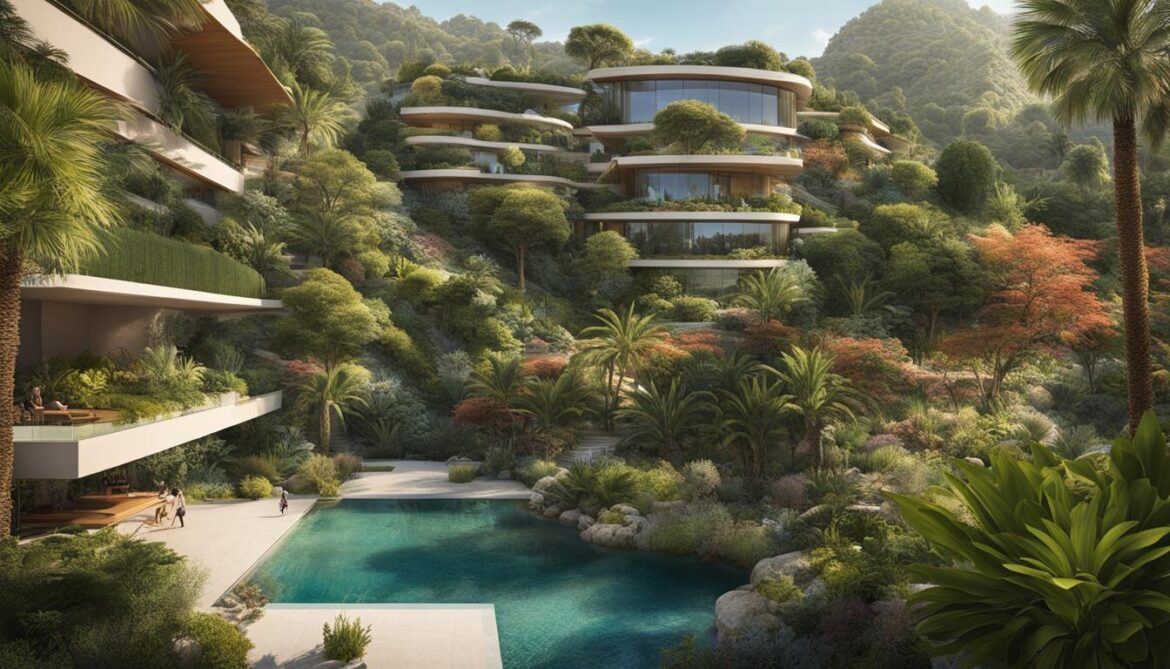
| Protected Areas |
Size |
Designation |
| Marine Protected Area 1 |
22 hectares |
IUCN Category V (Protected Landscape/Seascape) |
| Marine Protected Area 2 |
13.5 hectares |
IUCN Category IV (Habitat/Species Management Area) |
| PELAGOS Sanctuary |
2,083,997 hectares (total area) |
Specially Protected Area of Mediterranean Importance (SPAMI) |
Wildlife in Monaco
Monaco is home to a rich diversity of wildlife, including fascinating amphibians, beautiful birds, captivating mammals, and intriguing reptiles. While Monaco may be small in size, it still hosts a variety of species that contribute to the country’s unique biodiversity.
Currently, Monaco is home to one species of amphibian, twelve species of birds, four species of mammals, and five species of reptiles. Although none of these species are endemic to Monaco or considered threatened, their protection and preservation are essential for maintaining the ecological balance and biodiversity of the region.
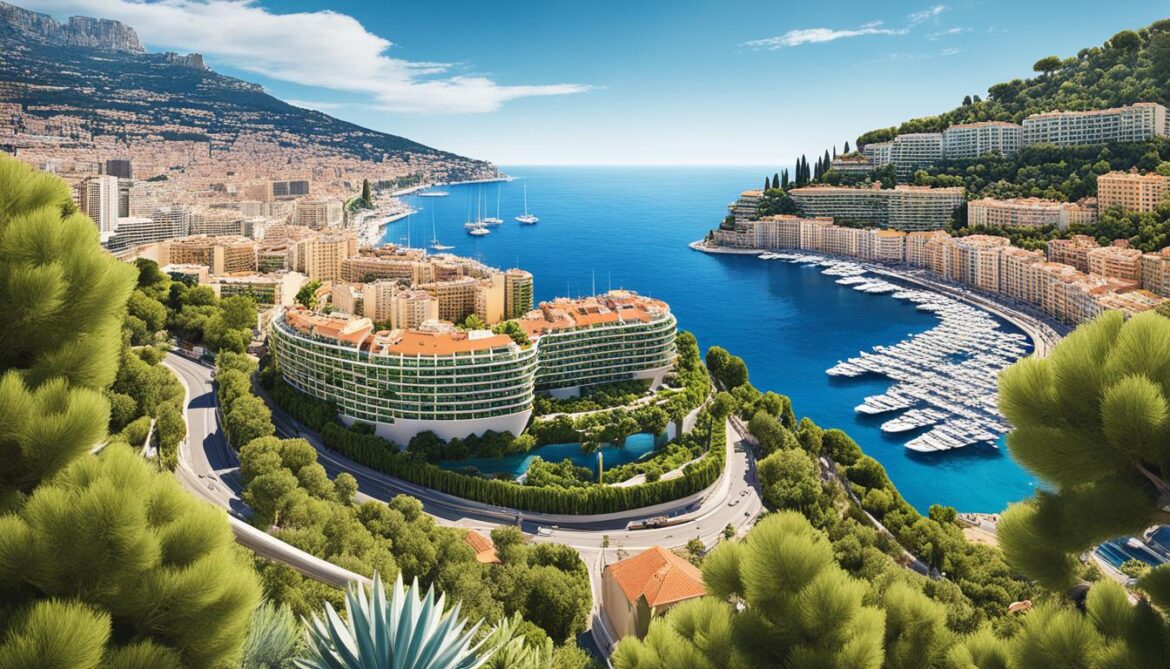
Amphibians in Monaco
Monaco is home to one species of amphibian, which plays an important role in the ecosystem as indicators of environmental health and habitat quality.
Birds in Monaco
With twelve species of birds in Monaco, birdwatchers and nature enthusiasts can appreciate the diverse avian life. From graceful waterfowl to soaring raptors, these birds contribute to the beauty and charm of Monaco’s natural landscape.
Mammals in Monaco
Monaco is home to a range of mammals, including small mammals like hedgehogs and shrews, as well as larger species like rabbits and foxes. These mammals add life and vitality to Monaco’s wildlife population and contribute to the overall ecological balance.
Reptiles in Monaco
Monaco’s reptiles, including lizards and snakes, are fascinating creatures that thrive in the region. They play important roles in controlling pest populations and contribute to the overall biodiversity of Monaco.
Preserving the wildlife of Monaco, from its amphibians and birds to its mammals and reptiles, is crucial for maintaining the country’s unique biodiversity. These species, although not endangered, deserve our attention and protection to ensure a sustainable and vibrant natural environment for future generations.
Plants in Monaco
The diversity of plant species in Monaco is limited due to its small size and lack of forested areas. Unfortunately, these factors have a significant impact on the plant diversity within the country. Without substantial forest cover, the number of plant species that can thrive in Monaco is restricted. As a result, Monaco does not have any known endemic plant species, which are plant species unique to specific regions.
However, despite the limited plant diversity, it is worth noting that Monaco does not have any tree species listed on the IUCN Red List as critically endangered, endangered, or vulnerable. This indicates that although plant species may be limited, the existing ones are not currently facing immediate threats to their survival.
Considering the impact of forest cover on plant species, the lack of substantial forested areas in Monaco poses a challenge for the expansion of plant diversity. Forests provide vital habitats and ecological niches that allow a wide range of plant species to flourish. Without these habitats, many plant species are unable to establish themselves and contribute to the overall biodiversity of Monaco.
“The absence of significant forest cover restricts the number of plant species that can thrive in Monaco.”
In order to promote plant diversity and further enhance Monaco’s natural environment, there is a need to explore alternative methods to support the growth and cultivation of plant species. This could include the implementation of green infrastructure, such as green roofs, vertical gardens, and urban landscaping, which can provide additional space for plant species to thrive in an urbanized environment.
By integrating plant diversity into urban design and planning, Monaco can create green spaces that not only improve the aesthetic appeal of the city but also contribute to the overall well-being of residents and visitors. Additionally, the cultivation of native plant species can help restore and preserve the unique flora of the region.
Plant Diversity and Biodiversity Conservation
Plant diversity plays a crucial role in biodiversity conservation. Plants provide essential ecosystem services, including habitat provision, food sources, and carbon sequestration. They are the building blocks of ecosystems and form the foundation of various food chains and webs.
In Monaco, efforts towards biodiversity conservation should also prioritize the preservation and expansion of plant diversity. Enhancing the presence of plant species can have cascading positive effects on other organisms, including insects, birds, and mammals that rely on them for shelter and sustenance.
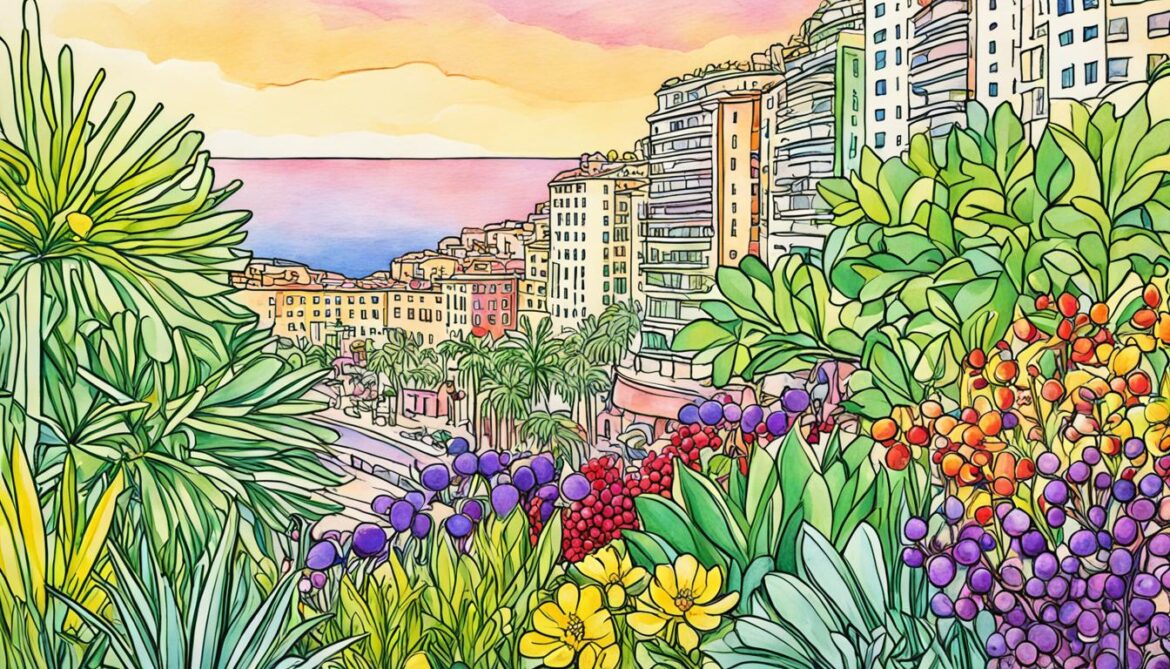
Environmental Protection in Monaco
Monaco actively participates in international agreements concerning climate change, biodiversity conservation, and marine pollution. The country recognizes the importance of safeguarding its natural heritage and strives to maintain a safe and sustainable living environment.
Monaco’s commitment to environmental protection is demonstrated through its involvement in various international agreements. By collaborating with other nations, Monaco contributes to global efforts in addressing environmental challenges and finding solutions.
Unlike many other regions, Monaco benefits from the absence of significant natural hazards, making it a relatively secure place to reside. This advantage allows Monaco to focus its resources on proactively implementing environmental protection measures and promoting sustainable development.
Through its commitment to international agreements and focus on environmental preservation, Monaco sets an example for other countries in their pursuit of a sustainable future.
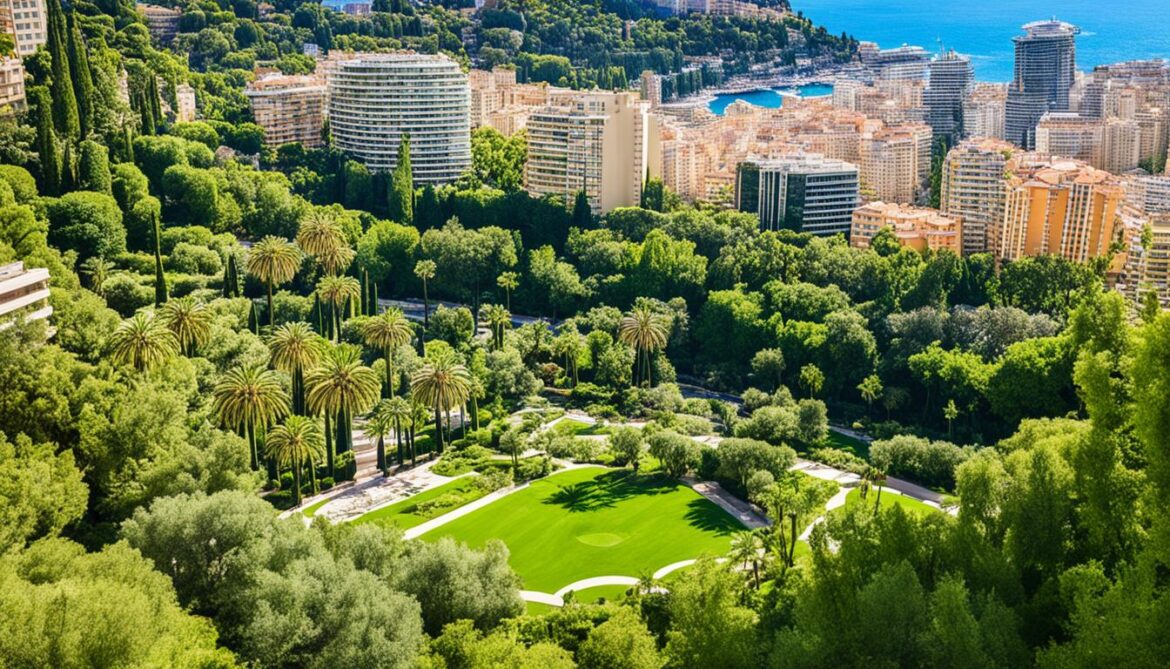
Need for Environmental Protection in Monaco
As an urbanized area, Monaco faces several environmental challenges that require careful planning and management. The principality is committed to environmental responsibility, taking proactive measures to minimize its ecological footprint and preserve its natural surroundings. Through the collaboration of the government and various organizations, Monaco strives to implement sustainable practices that promote the well-being of both residents and the environment.
One of the key initiatives in environmental protection is waste segregation. Monaco emphasizes the importance of proper waste management and encourages residents and tourists to separate their waste correctly. Recycling programs have also been implemented to reduce the amount of waste diverted to landfills, promoting the reuse of valuable resources. By embracing waste segregation and recycling, Monaco not only reduces its environmental impact but also sets an example for other urban areas to follow.
The Importance of Recycling Programs
Monaco recognizes the significant role of recycling in preserving the environment and conserving resources. The principality has implemented comprehensive recycling programs that cover various waste streams, including paper, plastic, glass, and electronic waste. These programs encourage responsible consumption and provide convenient recycling facilities throughout the region.
By promoting a culture of recycling, Monaco aims to reduce its overall waste generation and promote a circular economy. The principality’s commitment to recycling serves as a testament to its dedication to sustainability and environmental stewardship.
Driving Towards Renewable Energy
In addition to waste management, Monaco is actively promoting the adoption of renewable energy sources. The principality recognizes the importance of transitioning towards sustainable energy to reduce carbon emissions and combat climate change.
Monaco has made significant investments in renewable energy infrastructure, such as solar panels and wind turbines, to harness clean energy. These initiatives contribute to the principality’s goal of achieving carbon neutrality and serve as a model for other urban areas aiming to reduce their reliance on fossil fuels.
“Monaco’s commitment to waste segregation, recycling programs, and renewable energy showcases its dedication to environmental protection and sustainability.”
Overall, Monaco’s environmental challenges have paved the way for the principality to take a proactive stance towards environmental protection. Through waste segregation, recycling programs, and the promotion of renewable energy sources, Monaco is setting an example for other urban areas to follow. By prioritizing environmental responsibility, Monaco not only safeguards its natural surroundings but also upholds its commitment to a sustainable future.
Land Use and Resources in Monaco
Monaco, with its limited size, faces unique challenges in terms of land use and natural resources. However, the principality places great emphasis on careful land use planning to strike a balance between development and environmental conservation.
The preservation of green spaces, urban parks, and sustainable urban design are key considerations in Monaco’s development strategies. These aspects contribute not only to the aesthetic appeal of the city-state but also to the well-being and quality of life of its residents and visitors.
While Monaco may not possess significant natural resources, it has capitalized on its strengths and developed a thriving tourism industry. The principality’s scenic beauty, luxurious amenities, and unique charm attract visitors from all over the world.
In addition to its efforts in sustainable urban design, Monaco also places great importance on environmental preservation and protection. The principality recognizes that protecting its natural resources and implementing sustainable practices are essential for the long-term well-being of its residents and the preservation of its unique ecosystem.
Monaco’s approach to land use and resource management serves as a model for other nations facing similar challenges. Despite its limited size, the principality demonstrates that sustainable development is possible when careful planning, conservation, and innovation are employed.
Monaco’s Economy
Monaco boasts a thriving tourism industry that attracts visitors from around the world, making it a key driver of the principality’s economy. The allure of Monaco lies in its luxurious attractions, breathtaking landscapes, and vibrant culture, ensuring a memorable experience for tourists seeking an opulent getaway.
Moreover, Monaco has capitalized on its status as a tax haven, attracting individuals and companies alike with its favorable tax conditions. This strategic advantage has contributed significantly to the principality’s economic growth and prosperity.
However, Monaco’s commitment to sustainable development extends beyond its tourist appeal and tax incentives. The principality has successfully diversified its economic activities, with a keen focus on services and small, non-polluting industries. This approach ensures that Monaco’s economic growth remains sustainable and aligned with environmental principles.
Promoting Sustainability in Monaco’s Economy
Monaco’s dedication to sustainable development is reflected in its unwavering support for environmental protection, biodiversity conservation, and renewable energy initiatives. The principality actively engages in various projects and partnerships to promote a greener future, demonstrating its commitment to balancing economic growth with environmental stewardship.
- Environmental Protection: Monaco implements stringent regulations and policies to safeguard its natural surroundings and minimize the environmental impact of its economic activities.
- Biodiversity Conservation: The principality recognizes the importance of preserving biodiversity and has implemented measures to protect and enhance Monaco’s unique ecosystems.
- Renewable Energy Initiatives: Monaco actively promotes the adoption of renewable energy sources to reduce its carbon footprint and foster a sustainable energy future.
“Monaco’s economic success is intricately intertwined with its dedication to sustainable development, ensuring a harmonious balance between economic prosperity and environmental preservation,” says Lucien, a local business owner.
Monaco’s commitment to sustainable development echoes throughout its economy, guaranteeing a prosperous future for the principality without compromising its environmental integrity.
Monaco’s Economic Statistics
| Economic Indicator |
Value |
| Gross Domestic Product (GDP) |
$7.359 billion |
| Tourism Revenue |
$7.52 billion |
| Investment and Financial Services |
$6.08 billion |
| Small and Medium Enterprises (SMEs) |
$1.32 billion |
Monaco’s thriving tourism industry generates substantial revenue, contributing to its Gross Domestic Product (GDP). The principality’s investment and financial services sector also forms a significant part of its economy, attracting global businesses and investors.
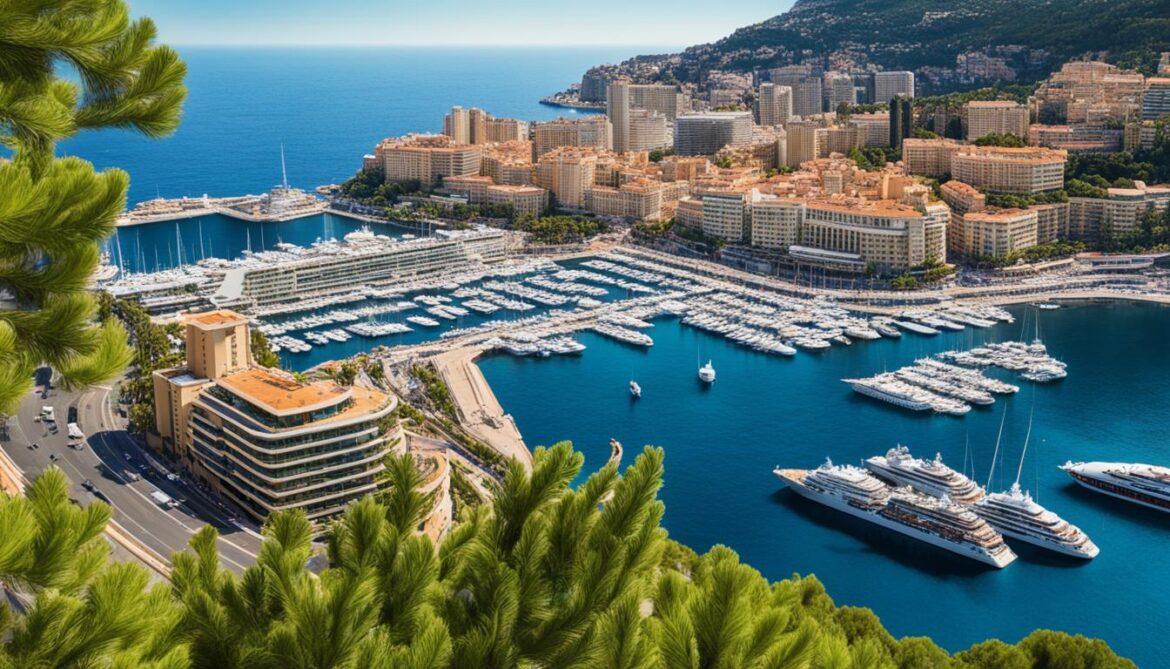
Sustainable Tourism in Monaco
Tourism is of great importance to Monaco’s economy. With its unique combination of luxury, entertainment, and natural beauty, the principality attracts visitors from around the world. Monaco has made significant strides in promoting sustainable tourism, evident through its commitment to eco-friendly practices in the hospitality sector.
The principality boasts a range of sustainable luxury hotels that prioritize environmental initiatives. These establishments integrate various measures to minimize their ecological footprint, from energy-efficient systems and water conservation to waste reduction and recycling programs. Monaco’s luxury hotels provide visitors with an exceptional experience while showcasing the principality’s dedication to sustainable practices.
Furthermore, Monaco has implemented several environmental initiatives to promote conscious consumption and reduce single-use plastic waste in the tourism industry. The principality has banned single-use plastic bags, straws, plates, cups, and cutlery, encouraging visitors and residents to adopt more sustainable alternatives. These initiatives contribute to the preservation of Monaco’s natural beauty and demonstrate a commitment to environmental stewardship.
Organic Dining in Monaco
In addition to sustainable hotels, Monaco offers a vibrant organic dining scene that caters to environmentally conscious visitors. Organic restaurants in Monaco prioritize locally sourced ingredients, supporting local farmers and reducing carbon emissions associated with long-distance food transportation. By embracing organic dining options, Monaco encourages visitors to make sustainable choices and supports the growth of organic agriculture in the region.
“Monaco’s sustainable luxury hotels and organic dining establishments showcase the principality’s commitment to eco-friendly practices.”
To further enhance the sustainable dining experience, Monaco emphasizes the use of biodegradable and compostable packaging materials. This shift away from single-use plastics demonstrates Monaco’s dedication to reducing plastic pollution and preserving its pristine environment.
A holistic approach to sustainable tourism is evident in Monaco’s commitment to luxury, environmental responsibility, and organic dining. Through these initiatives, the principality is setting a positive example for the global tourism industry, promoting sustainable practices that prioritize both visitor satisfaction and environmental preservation.
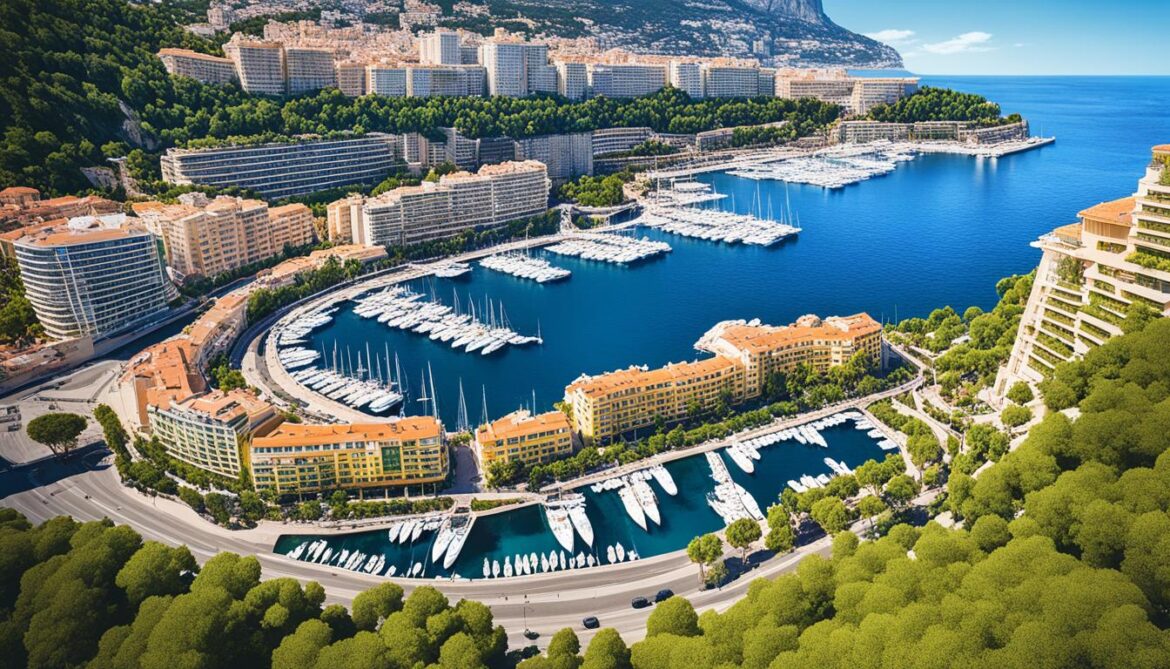
| Benefits of Sustainable Tourism in Monaco |
Actions Taken |
| Preservation of natural beauty and biodiversity |
– Implementation of eco-friendly practices in luxury hotels |
| Reduction of ecological footprint and carbon emissions |
– Bans on single-use plastic bags, straws, plates, cups, and cutlery
– Emphasis on organic dining and locally sourced ingredients |
| Promotion of conscious consumption among visitors |
– Encouragement of biodegradable and compostable packaging materials |
| Support for local farmers and organic agriculture |
– Integration of sustainability into the hospitality sector |
Sustainable Architecture in Monaco
Monaco is at the forefront of sustainable architecture and eco-friendly construction. The principality strongly advocates for energy-efficient design, and it boasts several impressive green buildings that prioritize energy efficiency and waste reduction. These architectural marvels serve as excellent examples of Monaco’s commitment to sustainable development.
Monaco’s dedication to sustainable architecture extends beyond individual buildings. The principality also prioritizes eco-friendly design in public spaces, including government offices, schools, and cultural institutions. By integrating sustainable principles into the construction and design of these public spaces, Monaco creates a harmonious blend of functionality, aesthetics, and environmental consciousness.
One notable aspect of Monaco’s sustainable architecture is its focus on obtaining LEED certification. LEED (Leadership in Energy and Environmental Design) is a globally recognized rating system that evaluates the environmental performance of buildings. Monaco’s commitment to achieving LEED certification showcases its determination to construct buildings that reduce their carbon footprint, use resources efficiently, and promote human health and well-being.
“Monaco is leading the way in sustainable architecture, showcasing environmentally conscious designs that inspire cities worldwide.”
Eco-Friendly Features
Monaco’s sustainable architecture incorporates a range of eco-friendly features that contribute to its overall environmental performance. These features include:
- Energy-efficient lighting systems
- Solar panels for renewable energy generation
- High-efficiency HVAC (Heating, Ventilation, and Air Conditioning) systems
- Rainwater harvesting systems for irrigation
- Natural ventilation and daylight optimization
- Building materials sourced from sustainable suppliers
| Building |
LEED Certification Level |
| Venturi House |
LEED Platinum |
| Green Tower |
LEED Gold |
| Monaco Technical and Hotel School |
LEED Silver |
The table above highlights some of Monaco’s remarkable green buildings and their corresponding LEED certification levels. These buildings serve as shining examples of Monaco’s commitment to sustainable architecture and demonstrate how environmentally conscious design can be integrated into various construction projects.
Monaco’s sustainable architecture not only contributes to the overall reduction of greenhouse gas emissions but also creates healthier and more livable spaces for residents and visitors. The principality’s dedication to sustainability in architecture sets a precedent for other cities around the world, inspiring them to adopt similar eco-friendly construction practices.
Conclusion
Monaco’s dedication to sustainability and biodiversity conservation is evident throughout its various initiatives and partnerships. The principality is actively working towards integrating biodiversity into construction practices, preserving wildlife habitat, and adopting sustainable urban design. By prioritizing environmental protection and renewable energy, Monaco sets an example for other regions to follow in creating a greener and more sustainable future.
Monaco’s commitment to protecting its natural heritage and promoting a sustainable future is commendable. Through its efforts, the principality aims to ensure the long-term preservation of its unique ecosystem. By incorporating biodiversity into construction practices, Monaco is creating a built environment that harmoniously coexists with nature.
In addition to biodiversity conservation, Monaco actively supports various environmental protection initiatives. The principality’s commitment to renewable energy sources and sustainable development strategies further reinforces its dedication to a more sustainable future. By focusing on environmental responsibility and adopting eco-friendly practices, Monaco demonstrates that economic prosperity and environmental protection can go hand in hand.
In conclusion, Monaco’s sustainable future relies on its continued efforts towards biodiversity conservation and environmental protection. Through sustainable architecture, integrated biodiversity practices, and renewable energy initiatives, Monaco is paving the way for a greener future. The principality’s commitment to sustainability serves as an inspiration and a model for others seeking to achieve a balance between development and environmental preservation.
FAQ
What is the impact of forest cover on Monaco’s biodiversity?
Forests provide vital habitats for a diverse range of species, so the lack of forested areas directly impacts Monaco’s biodiversity.
How many protected areas does Monaco have?
Monaco has limited protected areas, with two marine protected areas covering a total of 35.5 hectares.
What is the significance of the marine protected areas in Monaco?
The marine protected areas in Monaco are crucial for the conservation of marine biodiversity in the country’s territorial waters.
What is the PELAGOS Sanctuary?
The PELAGOS Sanctuary for Mediterranean Marine Mammals is a Specially Protected Area of Mediterranean Importance (SPAMI) designated by the Barcelona Convention, in which Monaco is a part.
What wildlife species can be found in Monaco?
Monaco is home to a variety of wildlife species, including amphibians, birds, mammals, and reptiles.
Are there any endemic or threatened wildlife species in Monaco?
None of the wildlife species in Monaco are endemic or threatened, but their preservation is still essential for maintaining Monaco’s biodiversity.
How is Monaco’s plant diversity affected by its limited forest cover?
The diversity of plant species in Monaco is limited due to its small size and lack of forested areas. The absence of significant forest cover restricts the number of plant species that can thrive in the country.
Are there any critically endangered, endangered, or vulnerable tree species in Monaco?
Monaco does not have any tree species listed on the IUCN Red List as critically endangered, endangered, or vulnerable.
What is Monaco’s stance on environmental protection?
Monaco actively participates in international agreements concerning climate change, biodiversity conservation, and marine pollution. The country recognizes the importance of safeguarding its natural heritage and strives to maintain a safe and sustainable living environment.
What environmental planning strategies are being implemented in Monaco?
Efforts are underway in Monaco to promote environmental awareness among residents and tourists through waste segregation, recycling programs, and the promotion of renewable energy sources.
How does Monaco balance development and environmental conservation?
Monaco emphasizes careful land use planning to strike a balance between development and environmental conservation. The preservation of green spaces, urban parks, and sustainable urban design are key considerations in Monaco’s development strategies.
How does Monaco contribute to sustainable tourism?
Monaco showcases its commitment to sustainable tourism through eco-friendly practices in luxury hotels and dining establishments. The principality has also implemented initiatives to reduce single-use plastic waste and promote conscious consumption.
What is Monaco’s approach to sustainable architecture?
Monaco is at the forefront of sustainable architecture and eco-friendly construction. The principality prioritizes energy efficiency and waste reduction in its top green buildings and public spaces.
What is Monaco’s vision for a sustainable future?
Monaco is dedicated to integrating biodiversity into construction practices, preserving wildlife habitat, and adopting sustainable urban design. The principality’s commitment to environmental protection and renewable energy serves as a model for other regions to follow in creating a greener and more sustainable planet.
Source Links






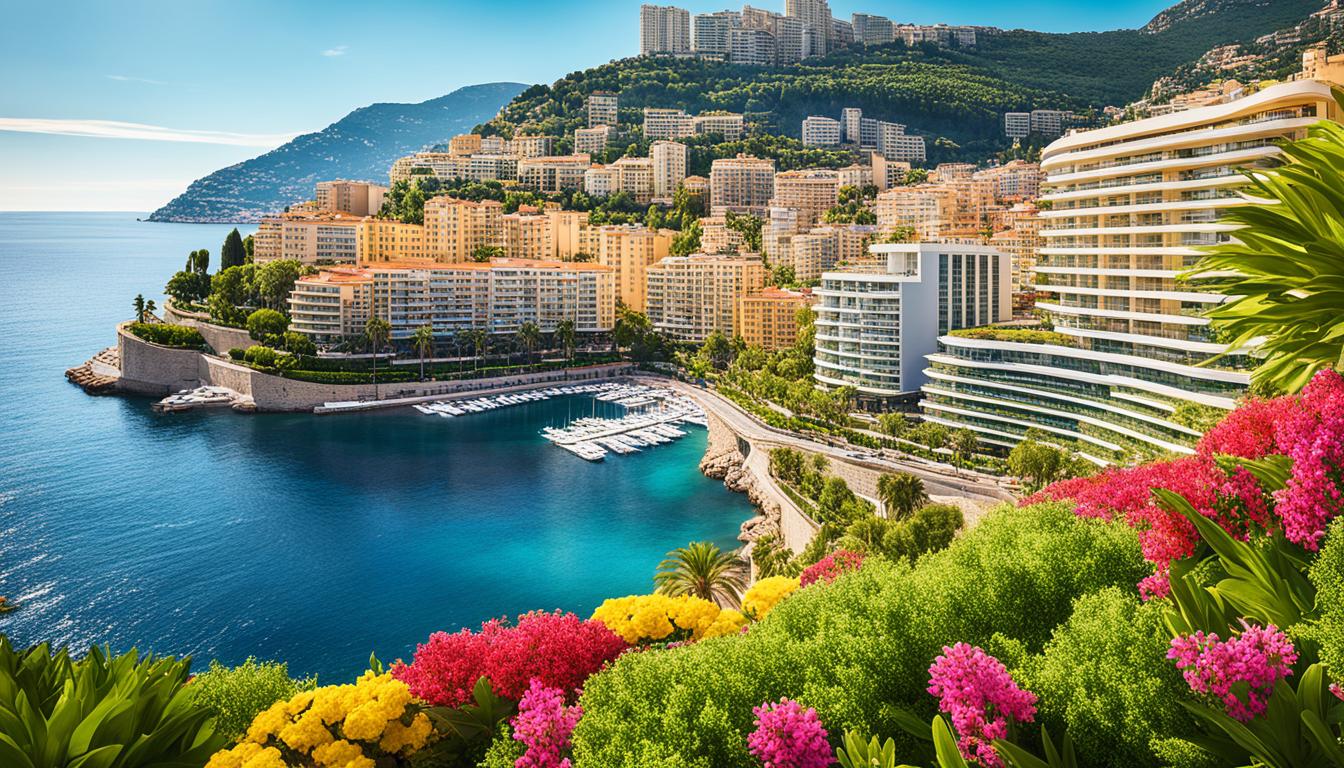


















Post comments (0)